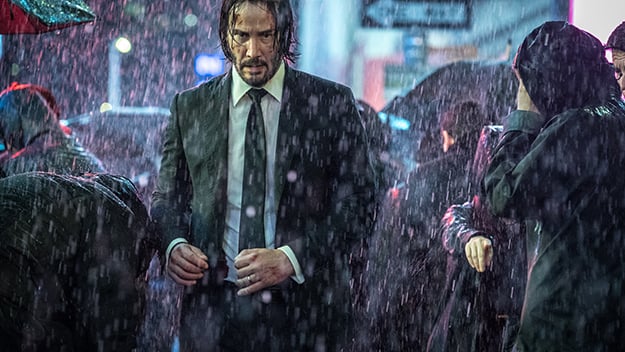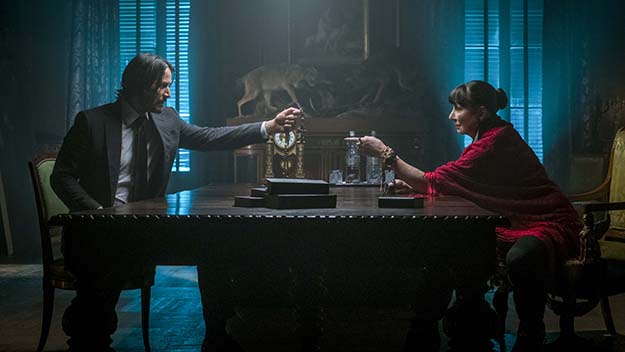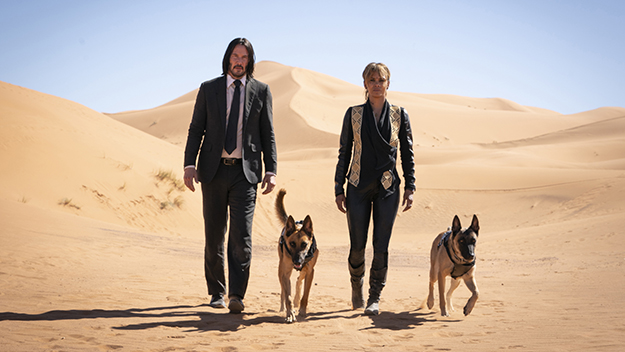Deep Focus: John Wick: Chapter 3 – Parabellum

All images from John Wick: Chapter 3 – Parabellum (Chad Stahelski, 2019)
John Wick: Chapter 3 – Parabellum carries the usual disclaimer, “American Humane monitored the animal action. No animals were harmed.” That’s especially good to know for a series triggered by its hero’s rage over the killing of a dog. Let’s hope someone is looking out for the humans. In the killer chiropractic choreography of a John Wick movie, bodies are folded, spindled, and mutilated. Any fight is done to the death except, that is, for rare occasions when super-assassin John Wick leaves an opponent breathing as a professional courtesy. Repeatedly we see why he’s nicknamed Baba Yaga, after a fearsome creature in Russian mythology. We’re told that Baba Yaga translates into “the boogeyman,” but as the first film taught us and the second one confirmed, Wick is “the man you send to kill the bogeyman.”
The film’s sustained hyperbole and the dark whimsicality of its setting—a parallel universe of crack assassins—enable us to accept outlandish atrocities as shocking punctuations to dance-like MMA and gun fu. A blade plunging into an eye—an image that has upset audiences from Luis Buñuel’s Un Chien Andalou (1929) to Irvin Kershner’s The Eyes of Laura Mars (1978)—here becomes a split-second coup de grâce that gets fans whooping and applauding. Buying a ticket to a John Wick movie is like signing control of your lizard brain away to the director, Chad Stahelski, for 130 minutes. Luckily, he knows what to do with it. We don’t leave the film with many rich or happy memories, but we do exit with a buzz.
In the original 2014 production, we meet Mr. Wick (Keanu Reeves) as an aspiring suburbanite who buries his assassin’s tools in the basement of his dream house but falls into a depression after the death of his angelic wife (Bridget Moynahan). One day when he’s filling up his gorgeous 1969 Ford Mustang Boss v29, a Russian punk at the next pump insists on buying it from him. After Wick refuses, the baddie and his buddies invade Wick’s home, steal his car, and fatally beat Daisy, his adorable beagle. (Helen ordered the pup so that after she died it would keep some love in Wick’s life.) What can any self-respecting former hit-man do but wipe out the Russian kingpin (and former employer) who happens to be the thief’s father? Later, Wick picks a Staffordshire bull terrier out of a shelter, a sturdy replacement for Daisy. But there’s no peace in their future. In John Wick: Chapter 2 (2017), an Italian gangster calls in a favor Wick owes him. The hit-man code requires that Wick honor the marker, though it pits an entire Mafia branch against him and he’s sure to be double-crossed in the end.

John Wick: Chapter 3—Parabellum continues the action, relating what happens after Wick executes the Italian on the neutral grounds of the New York Continental. (In the John Wickiverse, the Continental chain provides a safe space for assassins in major cities across the world.) Excommunicated from the international assassins’ guild and declared an open target by its leaders on “the High Table,” Wick roams Gotham with a $14 million bounty on his head. He escapes to Casablanca, seeks wisdom in the Sahara Desert, and returns to New York for another showdown with forces who vastly outnumber him.
Is this series wickedly cynical or shamelessly sentimental? Both, I’d say. Wick’s grief for his wife (and dog) is the film’s emotional fig leaf. We’re willing to suspend our disbelief in a hit-man with a heart of platinum as long as Reeves convinces us that Wick is worth rooting for. And that, Reeves does. Along with his percussive swiftness and agility, he combines shrewdness, resolve, and sincerity in unusually engaging and sometimes deadpan-funny ways. (Is there such a thing as wised-up earnestness? If so, Reeves has that, too.) The disconnect between Wick’s savage acts and Reeves’s intense, subdued demeanor allows the director to keep us guessing about Wick’s tactics and allegiance. Wick has no “super” abilities. As the Russian kingpin understood right away, his success rests on his iron will. Reeves persuades us that Wick uses his longing for his late wife as an emotional tether, before getting lost in the moment—and improvising a strategy about what comes next. Reeves benefits by drifting away from the first chapter’s primal revenge fantasies. Here Wick is less a retaliatory dark angel than a commando who snaps into action whenever his mind signals “fight or flight.”
Stahelski and his scriptwriters (Derek Kolstad, who also wrote the story; Shay Hatten; and the team of Chris Collins and Marc Abrams) vary the action without overloading the plot. Again they play Reeves’s reedy presence against McShane’s peerless suavity as Winston, the New York Continental’s manager, and Lance Reddick’s mellifluous, enigmatic amiability as its concierge, Charon. Even better, Anjelica Huston brings stiletto-like incisiveness to a character billed only as “the Director.” This Russka Roma gang leader guides the training of ballerinas and assassins in a lacquered show-biz palace called “the Tarkovsky Theatre.” Huston has charisma to burn. We feel her power even when she’s just jotting down dance notes. In her offhand-goddess manner, high-toned pulp dialogue about art as pain and life as suffering sounds as epigrammatic as Bertolt Brecht or Bernard Shaw. She’s proof that we can experience a complex sensibility as a riveting star presence. And on the other end of the acting spectrum, Halle Berry contributes an appealingly eager turn as Sofia, Wick’s reluctant Morocco-based ally. She matches up beautifully with Reeves and even better with Sofia’s dogs: a couple of Belgian Malinois who leap in and out of action at her command. They help to right the series’ canine karma.

The film exhibits its strengths and limitations in one of its most striking early sequences. Before the bounty hunt officially begins, a hulking liquidator, played by Philadelphia 76ers center Boban Marjanovic, tracks Wick to a library and tries to off him in the stacks. A heavy tome of Russian folklore becomes Wick’s weapon of opportunity: it’s as if he wants to shove some literature down the big brute’s throat. The bit is appalling and exciting, but also hermetic. The filmmakers ignore the humorous potential of readers sitting at their desks just a few yards away. Are they so concentrated on their books that they don’t hear anything, or do they consider this fight part of another wacky day in New York City? The movie’s “world-building” embraces both the golden splendors of a Casablanca palace and the grungy empire of Laurence Fishburne’s feisty “Bowery King.” It’s splashy but also thin: it rarely connects with our world, except when Wick interacts (in the previous films) with his mechanic (John Leguizamo) or a friendly cop (Thomas Sadosky).
Reeves, a prime mover for this series, must have learned from the disastrous Matrix sequels (with costar Fishburne) how much more potent an alternative universe can be when its mysteries are preserved, not spelled out. It’s a relief that the series never devolves into an origin story, not even when Wick, as an orphan from Belarus (who knew?), summons aid from Huston’s “Director.” Most important, Stahelski and company take full advantage of a movie-movie ambience. It’s delicious fun to see Wick—on horseback—confront homicidal motorcyclists in the middle of New York City. The Continental has become such a glossy location, I began to think it was dreamed up by Christopher Walken’s faux-suave SNL character “The Continental.”
The moviemakers’ passion for detail proves to be infectious in its own macabre way. Even murder-by-the-book develops in concrete anatomical stages. Later, when the unsettling Adjudicator (Asia Kate Dillon) calls in combat-suited warriors, Wick must adjust for the upgrades in their body armor. He stuns them over and over with body shots, then shoves their headgear up so he can blast away inside their helmets or at the bare flesh of their necks. It’s easier when Charon supplies him with armor-piercing shells.
Can Reeves and Stahelski sustain this carnage-laden fantasy? I’d love to see Reeves tackle different kinds of roles and challenges, as he did as a youth in Dangerous Liaisons (1988). There’s no question, though, that at age 54 he’s still all-in, acting with even more command and esprit as an action hero than he did in Speed and the Matrix movies. As long as he and his team keep finding new shadings in this dark palette, I’ll be happy if they continue burning Wick at both ends.
Michael Sragow is a contributing editor to Film Comment and writes its Deep Focus column. He is a member of the National Society of Film Critics and the Los Angeles Film Critics Association.







